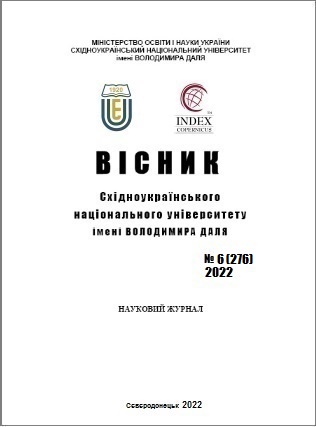Formation of business processes in art business as a tool of post-war recovery in Ukraine
DOI:
https://doi.org/10.33216/1998-7927-2022-276-6-61-66Keywords:
business processes, art business, financing, management, innovative approaches, digital challenges, modeling methodsAbstract
The article analyzes the state of business processes in the art business in Ukraine during the war period. Attention is paid to the development of new business processes aimed at the development of art business. New business processes in the art business system were covered.
The purpose of the article is to provide mechanisms for the formation of business processes in the art business in Ukraine in the post-war period.
It is noted that the post-war recovery tool in Ukraine is comprehensive recovery solutions that help quickly and effectively restore business processes in the art business. The development of new business processes as a response to the digital challenge is particularly relevant in the context of military operations in Ukraine. In recent months, museums, archives and other cultural institutions have made a good start in digitizing cultural heritage collections and developing digital services based on new business processes.
The concept of forming business processes to overcome critical moments in the art business system is presented. Concept of communication, income, growth, configurations and cooperation.
The article analyzes the formation of new waves of management, which is called the reengineering of business processes, aimed at changing the way of looking at the business process of work, how the work was carried out and radically streamlining the entire chain of actions in the direction of increasing efficiency and customer orientation. Using information technology as a means of implementation, art companies intend to change the overall structure of business processes instead of optimizing individual functions and departments.
The article concludes that a new wave of management is forming in Ukraine, called the reengineering of business processes, aimed at changing the way of looking at the business process of work, how the work was done and radically streamlining the entire chain of actions in the direction of increasing efficiency and customer orientation.
Analysis of existing business process modeling methods made it possible to create new methods for designing work and information processes. These methods should be focused on presenting business processes as deterministic sequences of management flow processes. Creativity in a business context means the generation of ideas that are both novel and can be purposefully transformed into products and processes. It was concluded that when modeling processes, it is necessary to take into account the rigid structuring of work processes.
The approaches presented in the article make it possible to apply business processes, which will make it possible to make reasoned economic and managerial decisions, to choose new areas of work in the art business system.
References
1. Данні українського культурного фонду [Електронний ресурс] – Режим доступу до ресурсу: https://uaculture.org/.
2. Пароваткина А. Арт-ринок під час війни: погляд Павла Гудімова / А. Пароваткина. // Дзеркало тижня. – 2014. – С. 16.
3. Драгович-Шешич М. Экономика культуры. Маркетинг организаций культуры / М.Драгович-Шешич // Артме-неджер. — 2002. — № 2. — С. 3—7.
4. Галуцкий Г.М. Основы финансов и финансирование ку-льтурной деятельности / Г.М. Галуцкий. — М. : Ассоц. экономики, науки и техники в сфере культуры, ин-форм. и досуга, 1996. — 223 с
5. Песоцька Е.В. Маркетинг услуг / Є.В. Песоцька. — СПб. : Питер, 2000. — 296 с.
6. Гройс Б. Язык денег / Борис Гройс // Художественный журнал. — М., 2003. — № 47. — С. 13—17.
7. Herrero M. Auction rituals and emotions in the art market / M. Herrero. — UK : University of Plymoth, 2010. – 10 p.
8. Kuspit D. Art Values or Money values: An Analysis of Art Prices in 2006 / D. Kuspit. — New York, 2007. — 13 p.
9. Goodwin J. The Essential Guide for collectors and investors / J. Goodwin. — USA : Kogan Page, 2010. — 448 p.
10. Вишеславський Г. Художні процеси у сучасному мис-тецтві України 1990-х рр. / Г. Вишеславський // Сучасне мистецтво : науковий збірник. — К., 2008. — Вип. V. — С. 7—62.
11. Булавіна Н. Нове розуміння актуального мистецтва / Наталія Булавіна // Сучасне мистецтво : наук. зб. / Ін-т проблем сучас. мис-ва Акад. мис-в України. — К. : Ак-та, 2005. — Вип. 4. — С. 13—17.
12. Бровко М. Методологічні аспекти дослідження фено-мена активності мистецтва / М. М. Бровко. // Гумані-тарний часопис. Київ.. – 2004. – №1. – С. С. 14–23.
13. Хармон П. и Гарсия Дж . (2020г.), «Состояние управ-ления бизнес-процессами в 2020г.», BPTrends, доступно по адресу: http://www.bptrends.com/bpt/wp-content/uploads/2020-BPM- Обзор.pdf.
14. Ли Дж. , Винер Г. и Пентланд Б. ( 2008г. ) , «Грамма-тика процесса как инструмент проектирования биз-нес-процессов»,MIS Quarterly, Vol. 32№4, с. 757.
15. Іванців О. Метафорічна модель «Бізнес-це мистецтво» як засіб формування корпоративного іміджу. / Іванців О.. // Культура і сучасність. – 2013. – №5. – С. 151–156
16. Remco Kossen. Collaboration and Business Models in the Creative Industry, Exploring heterogeneous collaborations [Електронний ресурс] / Remco Kossen, Peter van de Poel, Isabelle Reymen // Technische Universiteit Eindhoven – Режим доступу до ресурсу: http://www.item-eindhoven.org/images/pdf/Report_IIPCreate_project.pdf.
17. John Street. Collective Management Organizations, Creativity and Cultural Diversity [Електронний ресурс] / John Street, Dave Laing, Simone Schroff // CREATe Working Paper 2015/03. – 2015. – Режим доступу до ре-сурсу: https://zenodo.org/record/17860/files/CREATe-Working-Paper-2015-03.pdf.

